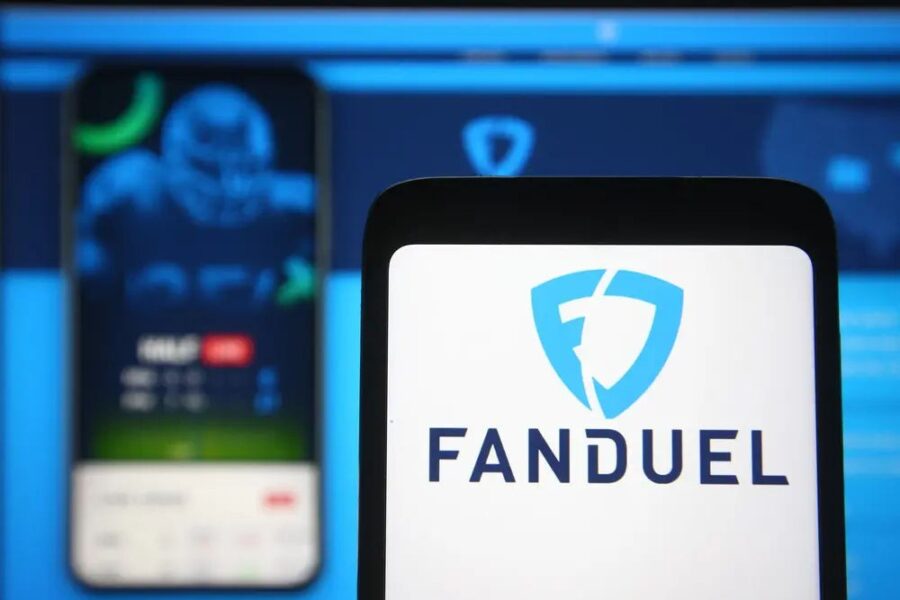Flutter selloff prompts analyst rebuke

Jefferies Equity Research analyst James Wheatcroft placed a “Buy” rating on Flutter Entertainment stock after a slump in the share price. “Today’s weakness in Flutter’s shares is an overreaction to prediction market developments,” he chided the market.
Shares in online sports betting providers such as Flutter, corporate parent of FanDuel, had taken a beating in the wake of Kalshi’s venture into single-game parlays, trumpeted during a Monday Night Football doubleheader. The Kalshi product allows for three-legged parlays on touchdown scorers, point totals and the result of the game.
“Recall, prediction market operators have made headlines in recent months … but have lacked the product depth of online sports betting operators,” Wheatcroft recapped. He noted that the newest Kalshi offering was an incursion on the kind of parlay wagering that represents 70% of Flutter’s income, “albeit with limiting features.”
Wheatcroft warned that additional, state-level regulation of OSB might lay ahead, since prediction markets do not pay state income taxes. One option would be for affected states to initiate further legal action against the interlopers, lest they suffer further tax losses.
Or, he posited, Congress might legalize federal-level sports betting. While on the surface this might look like a Flutter setback, Wheatcroft argued that the playing field would eventually tilt in its favor, “given its product understanding/capability… plus a material OSB product advantage.”
Flutter might also, he posited, enter prediction markets, arguing that Kalshi and its fellows were offering essentially the same content. Flutter executives have threatened to do this in earnings calls, noting their extensive European and United Kingdom experience in prediction markets.
However, Wheatcroft felt the newcomers would make scant headway against Flutter, because of a variety of factors. Foremost among these was that “consumers want breadth and depth of parlays across markets, games and sports. Offered only on select pre-match NFL markets, Kalshi’s new parlay product is less comprehensive.”
Another factor weighing in Flutter’s favor was its ability to offer player-based proposition bets, which constitute nearly half of its action. Also, FanDuel “retains the generosity edge with its US$2.3 billion annual US free-bet spend, a key moat for customer acquisition and retention.”
Wheatcroft also pointed to Jefferies research that discerned shrinking prediction-market returns in states where regulated OSB was on tap.
David McKee is an award-winning journalist who has three decades of experience covering the gaming industry.
Verticals:
Sectors:
Topics:
Dig Deeper
The Backstory
From parlay shock to market jitters
Flutter Entertainment’s recent volatility traces back to a new wrinkle in prediction markets that landed squarely on its core business. When Kalshi promoted single-game, three-leg parlays during a Monday Night Football doubleheader, investors balked at the potential overlap with the same multi-leg bets that have become a cornerstone of modern sportsbooks. A sharp selloff in Flutter shares followed. Yet Jefferies’ James Wheatcroft called the reaction overdone, noting the newcomer’s limited product scope and reach compared with operators that live and breathe parlays. He argued that the product “incursion” is meaningful but bounded, given FanDuel’s depth across markets, sports and player props, and its outsized free-bet engine. He also flagged the policy angle: prediction markets do not pay state taxes, which could spur litigation or new rules that change the economics. His view, laid out in a rebuke of the selloff, framed Kalshi as a catalyst rather than a category killer and suggested the long-term field tilts back to Flutter.
Analysts split signal from noise
The tension between near-term turbulence and long-term franchise value has dominated research notes on Flutter this year. In July, Wheatcroft set a Wall Street-high price target on Flutter and sketched the path to U.S. expansion even without fresh state launches, citing a diversified international base and maturing U.S. promotional discipline. He acknowledged slower handle growth but tied it to mix shifts toward higher-margin parlays, fewer promotions and softer sports calendars, not a structural fade. The analysis in his “strong buy” call leaned on margin resilience and cash generation by 2030, even as handle growth decelerated.
By January, Wheatcroft said investor debate had narrowed to growth versus valuation and would refocus on product differentiation. He highlighted Flutter’s personalization roadmap, including the My Way tool, and reiterated confidence in U.S. runway as more states consider legalization. His preview of the sector put Flutter at the center of investor attention, while keeping an eye on rivals like Entain as management shifts unfold. Together, the notes depict a company priced for scrutiny yet positioned to benefit as the market prizes product depth over promotional spend.
Margins, luck and the math behind the miss
Flutter injected caution into that bullish setup late in the year. The company cut 2024 U.S. revenue and EBITDA guidance after one of the most bettor-friendly NFL runs on record, with favorites winning at unusually high rates. Sportsbooks’ net revenue margin fell to 6.6% for the quarter, dragged by adverse results even as structural margins held near 14.5% and promos eased year over year. Flutter now expects U.S. revenue of $5.78 billion, down $370 million from the prior midpoint, and adjusted EBITDA of $505 million, a $205 million reduction. The company called the swing transitory and pressed ahead with a share repurchase program of up to $5 billion, promising a fuller update with fourth-quarter results and new guidance in March. The downtick and its drivers are detailed in the guidance revision, which underscores how streaky sports outcomes can swamp quarterly numbers even as product mix trends favor higher-margin bets.
That mix shift has been a subplot of the U.S. market. Handle growth slowed from 30% across the first three quarters of 2024 to 15% in the fourth, then 13% in early 2025. Flutter tracked below that, in part due to fewer state debuts and a cooler NBA season. But analysts stressed that igaming continues to grow near 30%, and that lower-stake, higher-margin products like parlays offset weaker headline handle. The Jefferies work linked easing promos to a natural drag on handle growth, while supporting profitability as the industry exits its land-grab phase.
Prediction markets move from headline to strategy
The Kalshi flashpoint also accelerated a strategic response. Flutter said it will partner with CME to step into event contracts under a federally regulated framework, initially focused on market, commodity and currency closes, with the flexibility to expand pending Commodity Futures Trading Commission approval. Truist’s Barry Jonas called the pivot “predictable,” arguing it gives FanDuel the plumbing to “turn on” sports-related contracts if it chooses, without jeopardizing state sportsbook licenses. He warned operators to tread carefully with state regulators and noted that federal views could shift with politics, but saw DraftKings and FanDuel-branded contracts quickly scaling if offered. His assessment of the CME deal positioned the partnership as both defense and option value.
Wheatcroft broadly agreed, saying the CME tie-up gives FanDuel the regulatory and technical backbone to move fast if the market opens. He stayed cautious on sizing the financial impact until the product slate lands. For now, both analysts see limited cannibalization where sports betting and prediction markets overlap, but acknowledge competition is improving as prediction venues add spreads and props. The policy risk runs both ways: prediction markets’ tax arbitrage in nonbetting states could drive state action, while federal-level sports wagering, if ever legalized, would scramble the map that sportsbooks know today. That dual-track uncertainty fed the selloff that Jefferies pushed back on, even as it validates Flutter’s hedging move with CME.
Product moat: depth, props and the promo flywheel
Amid the noise, analysts keep coming back to product. FanDuel’s moat rests on breadth and in-play capability across leagues, plus a heavy skew to player props that rivals struggle to match at scale. Wheatcroft points to player-based propositions making up nearly half of Flutter’s action, supporting margins even when favorites run hot. The company’s U.S. free-bet spend, pegged by Jefferies at $2.3 billion annually, remains a customer acquisition and retention lever as promo intensity across the industry cools. In the post-Kalshi note, Wheatcroft argued that customers want depth across markets and sports, an area where a single pre-match NFL product falls short. That logic underpins Jefferies’ conviction that temporary share price weakness belies underlying product strength.
Reputation, regulators and the Barcelona stage
With regulatory scrutiny a constant, Flutter is foregrounding sustainability and player protection as strategic assets. The company will headline the Sustainable Gambling Zone at ICE Barcelona in January, back a safer gambling charity fund and use the platform to showcase its Play Well program. The initiative targets 75% of active online customers engaging with safer play tools by 2030; by mid-2024, engagement reached 47.5%, double 2022 levels. Flutter spent more than $101 million in 2023 on research, product and marketing tied to safer gambling. The details are in the Barcelona sponsorship, which signals to regulators and partners that growth and consumer protection can move in lockstep.
That message matters as lawmakers weigh how to police the gray zone between prediction markets and sportsbooks, and as operators press for stable tax regimes. If policy hardens against prediction markets, regulated operators could gain relief from leakage. If federal legalization enters the conversation, scale players with compliance muscle and national brands would have first-mover advantages. Flutter’s recent steps — defending its parlay franchise, preparing an event-contract option, and leaning into responsible gambling — sketch a playbook aimed at both outcomes.








